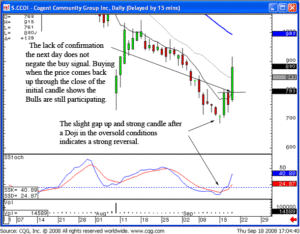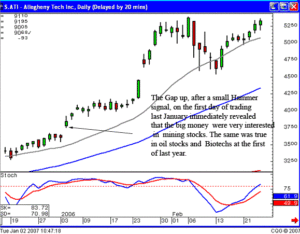Simple Stop Loss Strategies can be easily used with Japanese Candlestick trading.
One of the most often-asked questions we receive at the Candlestick Trading Forum is how to use candlestick analysis as part of a simple stop loss strategy.
The fact is, not only is candlestick analysis ideal for pinpointing the exact time the successful trader or investor should enter the trade, but it is equally valuable in stop loss strategies. The proper use of candlestick analysis provides a simple, visual representation of the exact point in time when the reason for buying or shorting no longer exists.
Once you deeply, truly understand candlestick trading tactics, you will soon come to the realization that most of trading is just plain common sense. But, as I believe Mark Twain said, “Common sense is not that common”.
It amazes me each and every day to see all these “brilliant” stock annotators and stock analysts attempt to explain what happened in the market that day. As if the market cared one bit about their stock market fundamental and technical analysis. But I guess these guys and gals are just trying to do their job, feeding the all-too-human need of “Having to Know Why Something Happened”.
Candlestick Traders don’t need to know “why something happened”. They just look at the candlestick chart patterns and know “something happened”. In a strong reversal pattern, “something happened’ to totally change the HUMAN EMOTIONS of the HUMAN BEINGS buying or selling that stock or commodity. After all, the candlestick patterns are simply the visual representation of human psychology – of Greed and Fear.
So, when using simple stop loss strategies in their overall stock trading system, the Candlestick Trader does not need to know WHY the stock is now going down after they bought it. The fact is, it IS going down. The psychology has changed.
Simple Stop Loss Strategies Involve Knowing The General Market Direction. The investment psychology of the market, in general, can be easily seen in the Japanese Candlestick signals. Use that stock market information to change the makeup of your portfolio. During “iffy” periods, having long and short positions will provide better probabilities to make profits, even when the direction of the market is not clear.
Stop Loss Strategies and Techniques using the candlestick method
Protecting your assets – that is the main objective for putting on stop losses. The stop loss objective is to provide a point where the reason for buying or shorting becomes null and void. Many stock market strategies incorporate stop loss objectives into their trading formulas for closing a trade gone sour. Usually this is done by establishing a percentage loss as the parameter. Here is the first myth to be bashed: The candlestick method completely disregards a preset formula for stopping out.
One of the major investing mistakes is using a prescribed percentage as the stop loss. Your purchase price becomes an important function of where you are to stop out. The stock market investing advice given by some investment advisors recommends three percent as the stop-out level. Others suggest eight percent. But where you buy a trade position now becomes the quantitative element of where you should place your stop.
The most important factor for establishing a stop loss is very basic. What price point would indicate the established trend has been negated? This now becomes a stop loss level established based upon the trend being stalled and/or negated.
As with all of candlestick analysis, this becomes a ?common sense? evaluation. If you have put on a long position based upon a bullish buy signal, where would the price have to back off to confirm that the sellers were still in control?
A signal has significant meaning. Knowing that, the thought process for when to stop out of a trade becomes easy. A buy signal indicates a new trend. What would counter that ?indication??
Probabilities mean being in that trade has favorable odds for profitability, not any guarantees. Even though a majority of trades will work using the signals, some trades won?t work. Keeping that mindset in focus as well as other candlestick basics, stop loss analysis creates a format for identifying when a trade is not working and getting out of the trade as soon as possible.
Establishing the stop loss point involves using the same common sense approach incorporated throughout the candlestick method and other stock investing concepts.
Studying stock chart patterns will vastly improve your ability to recognize when and where a stop loss should be placed on a trade. Study candlestick chart formations with extensive downtrends. Often a fizzled buy signal can be found. Recognize what the trading candles did after the buy signal and what selling candles negated the buy signal.
Keep in mind that all trades do not work. Learn to move out of those trades and move to other trades immediately.



